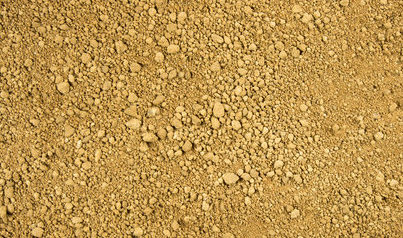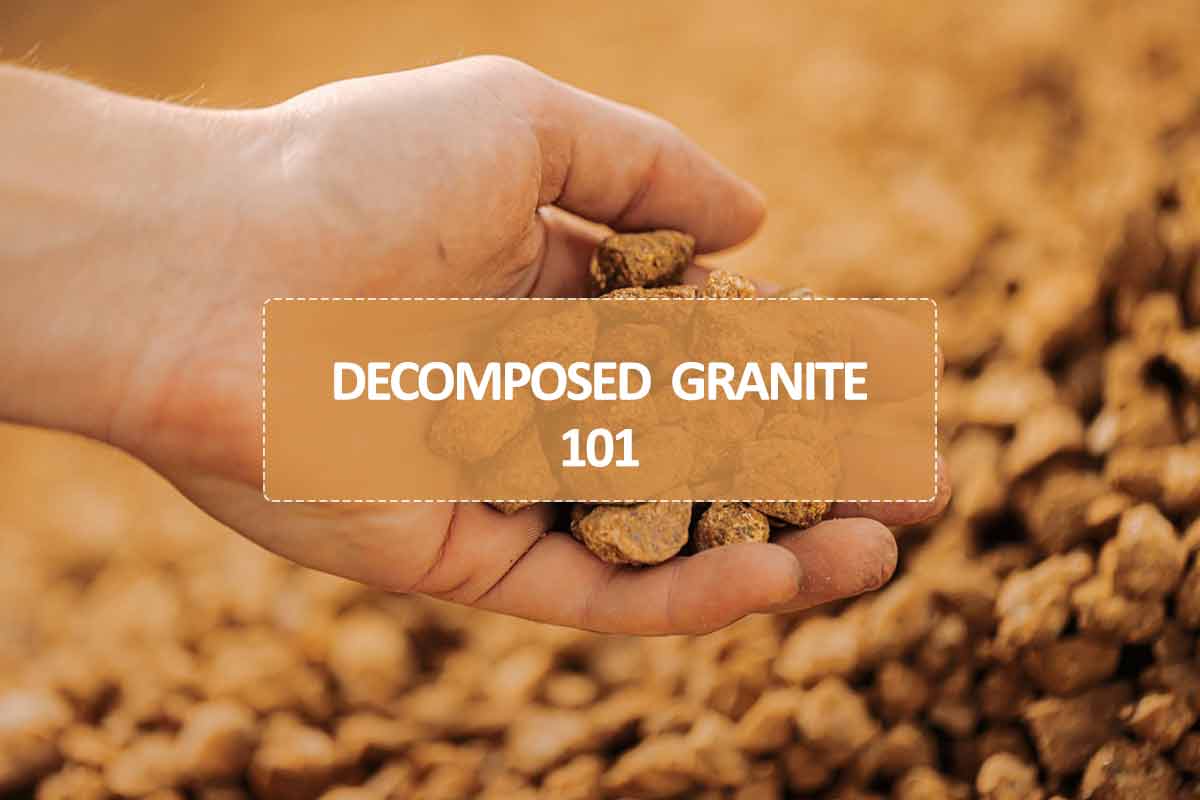Decomposed granite, or DG for short, is now all the rage for surfacing pathways and other hardscape features in oriental gardens.
DG is derived from the weathering and erosion of solid granitic rock. This results in a material composed of very fine dust particles (clay and silt), small sand-like granules, and larger rock (about 3/8 inches in size).
This composition allows DG to compact very well to form a stable surface capable of handling foot and vehicular traffic. Large particles provide strength, sand-sized particles act as filler material while the fines, clay in particular, act as the binding agent (or glue) that holds the larger particles together.
Decomposed granite can be used as a lawn replacement, on pathways and trails, as bedding material for pavers, bricks, and flagstone, and on driveways. A binding agent or stabilizer can be blended into the material to form a durable surface capable of handling heavy foot and vehicular traffic.
What is Decomposed Granite?
Granite is the most common igneous rock on God’s green earth. Composed of feldspar, quartz, and mica, it forms when magma or lava slowly cools and solidifies below the Earth’s surface. Granite has been used for thousands of years, from making ancient tools to modern countertop installations.
Now, decomposed granite is formed when the granitic rock weathers and erodes over time due to freeze and thaw cycles, rainfall, and wind. One of the components, feldspar, is especially susceptible to chemical weathering when exposed to water. Weathering breaks it down into a clay mineral called kaolin, which further deteriorates when exposed to more water.
This leaves behind rocks that crumble and that can be quarried directly from the over 100 gravel pits in the US. In some cases, the gravel is screened to sort it by size.
Decomposed Granite Pros & Cons
Pros:
- It’s low maintenance.
- It’s cheap and natural adding a rustic flare to your outdoors.
- DG can handle foot and vehicular traffic.
- It’s permeable and allows rainfall to replenish groundwater instead of pooling on the surface.
- DG won’t hold on to heat as much as concrete or asphalt does.
- It is a versatile material. It’s low-profile and will blend in with other materials.
- DG comes in over 30 colors and shades such as brown, pink, blue, black, rose, gold, and white among others.
Cons
- It easily tracks indoors, scratching up those fancy hardwood floors you got.
- DG can shift and get washed off if it’s not properly installed.
- Weeds and moss can grow over it, necessitating occasional removal.
Types of decomposed granite
Well, there are three main forms of DG: Raw, stabilized, and resin-coated DG, each with its unique features and characteristics.
- Raw/Loose DG: This is decomposed granite with no additives. It’s the least expensive option and can be used for all sorts of projects; paving patios, pathways, driveways, playgrounds, bocce, and baseball courts.
- Stabilized DG: Can handle heavier traffic while minimizing dust and slush. The binding agent is either pre-mixed into the aggregate before application or sprayed on.
- Resin or Polymer-coated DG (poly pavement): This is decomposed granite with resin, oil, enzyme, or wax-polymer binder added in. It is easily the priciest option, but it’s also the strongest and most durable. Perfect for high foot and vehicular traffic.
Uses of Decomposed Granite
- Instead of a high-maintenance lawn, try carpeting your outdoor space with DG! You can use it to create outdoor kitchen surfaces, lounging areas, or patios.
- DG is great for dressing up pathways, garden trails, golf course pathways, and driveways. For added durability, you can engineer it with a stabilizer.
- Mulch for your flowers or trees? DG can do that too! It helps with moisture retention and minimizes weed growth
For more on decomposed granite uses, click here.

Buying Decomposed Granite
If you’re looking to get your hands on some decomposed granite (DG), there are a few ways to go about it depending on the scale of your project.
You can find bagged options at retail stores like Lowes and Home Depot. But for bigger projects, bulk DG is the way to go and is way cheaper. It is usually purchased by the cubic yard. You can either haul it yourself or have it delivered at a fee.
Be sure you are buying decomposed granite that is smooth to touch and not crushed material that is rough and angular.
Cost:
You can expect to pay somewhere between $50 to $90 per cubic yard of loose DG. Stabilized DG can easily cost around $185 per cubic yard.
For professional installation instead of DIY, you are looking at around $5 per square foot.
Decomposed Granite Installation
First, measure, mark, and excavate your project site to around 4 to 6 inches of depth. Get the surface nice and flat.
Add edging to keep everything in place and to define the border. You can use bricks, pavers, pressure-treated wood, metal, or composite bender boards as edging.
Lay down heavy-duty landscape fabric (geotextile). This will separate the soil from the base layer, preventing the two from mixing.
Spread 2 to 4 inches of angular base gravel, level, and compact it. Then spread the DG on top to a depth of 2 to 4 inches in 1.5-inch lifts. Compact each layer to make it nice and stable.
Screed the surface using two 1-inch galvanized pipes or edging as guiding rails to level it out. Remove excess material in high spots, fill in any low spots, and level it before dampening it and compacting it using a rented vibrator plate compactor, drum roller, or hand tamper.
Ideally, decomposed granite should be installed on relatively flat or slightly sloping surfaces. On steep slopes, the material can easily be dislodged and eroded when challenged by a stream of water, forming ruts (grooves) on the surface.
Maintaining Decomposed Granite
Keeping decomposed granite (DG) in good shape is easy. It involves regular cleaning and periodic application of stabilizer to preserve its look and durability.
Here are some tips for maintaining your DG:
- Weed control: Weeds can grow anywhere, especially on loose DG. Pull them out as soon as they sprout.
- Reapplying stabilizer: The spray-on stabilizer may degrade over time. Scarify the surface, apply more stabilizers then re-compact the surface. How often to do this depends on the quality of the stabilizer and how much traffic it handles.
- Resurfacing: If your DG surface gets uneven, refill any low spots to even it out. Use a rake or broom to spread the DG evenly, moisten it, and then compact it with a roller or tamper.
To wrap up
If you’re looking to spruce up your outdoor space, look no further than decomposed granite! This versatile material adds a rustic touch to your outdoor space.
Whether you’re a homeowner or a business owner, DG is cost-effective and tough-as-nails. With its low friction coefficient, corrosion resistance, and ease of use, DG is a true workhorse that’ll keep on shining year after year!
That’s it. Until next time!


